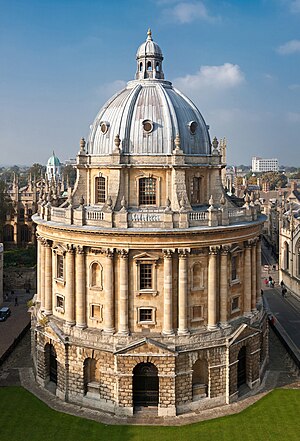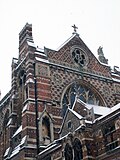| Main page | Indices | Projects |
The University of Oxford portal
The University of Oxford is a collegiate research university in Oxford, United Kingdom. There is evidence of teaching as early as 1096, making it the oldest university in the English-speaking world and the world's second-oldest university in continuous operation. It grew rapidly from 1167, when Henry II banned English students from attending the University of Paris. After disputes between students and Oxford townsfolk in 1209, some academics fled north-east to Cambridge where they established what became the University of Cambridge. The two English ancient universities share many common features and are jointly referred to as Oxbridge.
The University of Oxford is made up of 43 colleges, consisting of 36 semi-autonomous constituent colleges, four permanent private halls and three societies (colleges that are departments of the university, without their own royal charter), and a range of academic departments which are organised into four divisions. Each college is a self-governing institution within the university, controlling its own membership and having its own internal structure and activities. All students are members of a college. The university does not have a main campus, but its buildings and facilities are scattered throughout the city centre. Undergraduate teaching at Oxford consists of lectures, small-group tutorials at the colleges and halls, seminars, laboratory work and occasionally further tutorials provided by the central university faculties and departments. Postgraduate teaching is provided in a predominantly centralised fashion.
Oxford operates the Ashmolean Museum, the world's oldest university museum; Oxford University Press, the largest university press in the world; and the largest academic library system nationwide. In the fiscal year ending 31 July 2023, the university had a total consolidated income of £2.92 billion, of which £789 million was from research grants and contracts.
Oxford has educated a wide range of notable alumni, including 30 prime ministers of the United Kingdom and many heads of state and government around the world. 73 Nobel Prize laureates, 4 Fields Medalists, and 6 Turing Award winners have matriculated, worked, or held visiting fellowships at the University of Oxford, while its alumni have won 160 Olympic medals. Oxford is the home of numerous scholarships, including the Rhodes Scholarship, one of the oldest international graduate scholarship programmes. (Full article...)
Selected article
The Council of Keble College, Oxford ran the college (in conjunction with the Warden) from its foundation in 1868 until 1952. The council – a group of between nine and twelve men – has been described as "an external Council of ecclesiastical worthies", as most of the members came from outside the college, and many were not otherwise linked to the university. Keble was established by public subscription as a memorial to the clergyman John Keble. The first council members were drawn from the committee whose work had raised the money to build the college. By keeping matters relating to religion and the college's internal affairs in the hands of the council, the founders hoped to maintain Keble's religious position as "a bastion of 'orthodox' Anglican teaching" against the opponents of Tractarianism. In total, 54 men served on the Council, 11 of whom were college alumni; in 1903, Arthur Winnington-Ingram (Bishop of London) became the first former Keble student to join the council. It ceased to exist after 9 April 1952, when new statutes of the college placed full management in the hands of the Warden and Fellows. (Full article...)
Selected biography
Alfred Denning, Baron Denning (1899–1999) was a British soldier, lawyer and judge. He studied at Magdalen College, Oxford, although his studies were disrupted by his service in the First World War. He then began his legal career, distinguishing himself as a barrister and becoming a King's Counsel in 1938. He became a judge in 1944 with an appointment to the Family Division of the High Court of Justice and was made a Lord Justice of Appeal in 1948 after fewer than five years in the High Court. He became a Lord of Appeal in Ordinary in 1957 and after five years in the House of Lords returned to the Court of Appeal as Master of the Rolls in 1962, a position he held for twenty years. One of the most publicly known judges thanks to his report on the Profumo Affair, Lord Denning was held in high regard by much of the judiciary, the Bar and the public. In retirement he wrote several books and continued to offer opinions on the state of the common law through his writing and his position in the House of Lords. During his 38-year career as a judge he made large changes to the common law, particularly while in the Court of Appeal. (more...)
Selected college or hall
Selected image

Did you know
Articles from Wikipedia's "Did You Know" archives about the university and people associated with it:
- ... that British surgeon Theodore Dyke Acland was the son-in-law of Jack the Ripper suspect Sir William Gull (pictured)?
- ... that at the 1895 United Kingdom General Election, Tankerville Chamberlayne's election as a Member of Parliament was declared void because of electoral fraud?
- ... that Arthur William Hodge was the only white person in the history of the British West Indies to be executed for killing a black slave?
- ... that Lord Michael Fitzalan-Howard and his seven siblings all had first names beginning with the letter "M"?
- ... that it took over 50 years to complete the foundation of Jesus College, as one Principal lost the draft statutes and the next one kept the replacement copy in his study for several years?
Selected quotation
Selected panorama
On this day
Events for 3 July relating to the university, its colleges, academics and alumni. College affiliations are marked in brackets.
|
Births
|
Deaths
|
Wikimedia
The following Wikimedia Foundation sister projects provide more on this subject:
-
Commons
Free media repository -
Wikibooks
Free textbooks and manuals -
Wikidata
Free knowledge base -
Wikinews
Free-content news -
Wikiquote
Collection of quotations -
Wikisource
Free-content library -
Wikiversity
Free learning tools -
Wikivoyage
Free travel guide -
Wiktionary
Dictionary and thesaurus













